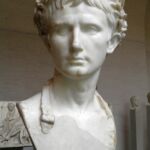The temple of Augustus and Roma in Pula (Croatia) was built at the end of the reign of the first emperor Octavian Augustus (27 BCE – 14 CE). The building was built on the podium; the front of the temple consists of a portico supported by columns in the Corinthian style.
The structure of the temple in Pula resembles another Roman temple in Nimes (France) with its structure and rich frieze. Both buildings are considered the best-preserved Roman temples outside Italy.
The temple had an inscription made of bronze letters, attached with nails to the front of the building. She proclaimed:
ROMAE · ET · AVGVSTO · CAESARI · DIVI · F · PATRI · PATRIAE
so
To Roma and Augustus Caesar, son of the deity, father of the fatherland
In the 4th century CE, the temple was closed due to the persecution of the followers of traditional Roman deities. Later, the sanctuary was transformed into a church to fulfil the function of a granary.
In the vicinity of the temple of Augustus and Roma, there was a temple of Diana in Roman times, the back wall of which was incorporated into the Communal Palace in the 13th century.








